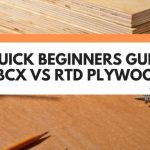Plywood is an engineered wood that is made up of thin sheets of timber veneer glued together. These multiple ‘ply’ sheets help to make this all-purpose material.
Yet despite being made up of wood layers, plywood isn’t as durable or as sturdy as normal wood. And this can be a problem when it comes to using powered or manual tools on it.
So, how do we reduce the thickness of plywood?
It depends on how big the plywood sheet is. For small projects, you can use a basic hand-held block plane (without plywood’s glue adhesive becoming a sticky problem).
If you are working with a medium to large sized piece of plywood then you could consider using a belt sander, (or a router with a flush trim bit), to reduce its thickness.
But, those are just a handful of options you can try. Keep reading to discover more about all of the different ways you can thickness plane plywood…

This post may contain affiliate links to products that we receive a commission for (at no additional cost to you). Learn more here.
Can You Thickness Plane Plywood?
The short answer to this is, yes, you can thickness plane plywood. However, the real questions you should be asking are as follows;
A). Should You Plane Plywood?
You need to be cautious about how you plane plywood, especially as you don’t want to ruin the veneer (by planing down too far).
Nor do you want to deal with splitting the layers of ply, (which can occur if the glue adhesive doesn’t hold up well against the exertion of the plane).
B). What Tool Should You Use To Plane Plywood With?
Woodworkers have tried everything from routers to planers to good old manual hand planes on strips of plywood.
But not all tools are made equal when it comes to getting the job done in this instance.
Related Post: Can You Use RTD Plywood For Roof Sheathing?
How To Make Plywood Thinner
Tip No. 1 – Using a Block Plane
Can You Use A Block Plane on Plywood?
The slightly more complicated answer to this question is ‘yes and no’. Let me explain;
YES: If you only want to take small pieces off the wood then a block plane, (plus a steady hand and a bit of patience), is all you need.
NO: If you have a large piece of plywood to work through, then you are going to need infinite amounts of patience to work over it with just a block plane tool.
So in this instance, I recommend you use a power tool, specifically a Orbital Sander.
Talking of planes, have you ever wondered what a Bench Plane is used for? Click here to learn more about this classic carpenters hand tool.
Tip No. 2 – Use a Belt Sander
Can You Sand Plywood Edges?
You can sand plywood across the surface and the edges, but you need to be extra careful to not rip through the layers.
You will need to use something like 150-grit sandpaper to work on the layers. But, avoid using very high grit sandpaper, as they will simply be too rough on the veneers.
Alternatively, if you are using an orbital sander, you are going to need to apply an incredibly light touch. So opt for a low grit sandpaper in this instance, using something around 60-grit on the orbital sander.
Also, give the orbital sander a bit more stability and resistance by purchasing and working with stronger plywood sheets.
Which Plywood Is Strongest?
When it comes to plywood, its strength lies in its adhesive.
The stronger the adhesive, the greater the bonds between the layers. And the greater the bond between layers, the stronger the plywood.
So which plywood is strongest? Marine plywood is strongest by far, thanks to its top-quality moisture-resistant bonding glue.
Orbital Sanders aren’t the only power tools you can use on plywood. Click here to learn how you can use a router on plywood.
Tip No. 3 – Glue Multiple Sheets Together
Another idea you could try is to ‘cheat’ and just skip over the planing task altogether.
And what I mean by this is that you could instead simply glue very thin sheets of plywood together yourself, in order to get the thickness you want.
In other words, instead of planing down thick plywood sheets, you could try layering up thin plywood sheets.
Decide on the thickness you want, and divide it by a standard plywood sheet.
What Is The Standard Thickness of Plywood?
The thickness of plywood is more of a range than a single standard measurement.
You can get plywood as thin as one-eighth of an inch, all the way up to three-quarters of an inch thick.
The most commonly sold thickness size is 1/2 inch plywood.
How Do You Measure Plywood Thickness?
Just because the store says the ply is 1/2 inch thick, doesn’t mean that is its ‘real world’ thickness measurement.
The quoted thickness of plywood is simply the ‘nominal’ thickness.
However, a sheet of plywood can be up to 1/32 thinner than the quoted thickness.
Typically, such a small differential in size isn’t all that important when it comes to most types of woodworking projects.
But, if you want to know the actual thickness of a specific sheet of plywood, you are going to have to measure it yourself using a Speed Square or a Tape Measure.
Final Thoughts
Keep in mind, planing down this particular manufactured wood is going to require a delicate touch, no matter what method you choose.
But, if you really need to reduce the thickness of plywood, then you have a few options;
- If you are working with a small sheet of plywood, then use a block plane.
- If you are working with a large sheet, then use a sander.
- If you are using a high-strength plywood, such as Marine Plywood, then you can consider (carefully!) using an orbital sander.
References
https://www.homedepot.com/c/ab/types-of-plywood/9ba683603be9fa5395fab909d37f448
https://www.inchcalculator.com/actual-plywood-thickness-size/



